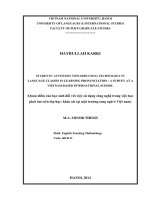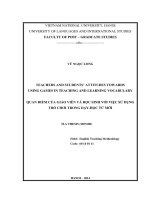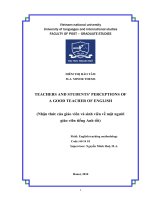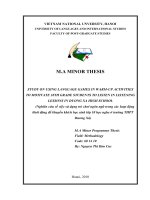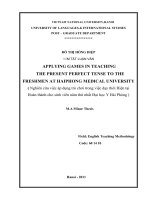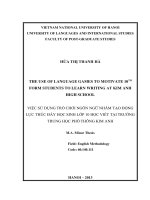teachers and students’ attitude towards using games in teaching and learning vocabulary = quan điểm của giáo viên và học sinh với việc sử dụng trò chơi trong dạy - học từ mới
Bạn đang xem bản rút gọn của tài liệu. Xem và tải ngay bản đầy đủ của tài liệu tại đây (877.7 KB, 46 trang )
VIETNAM NATIONAL UNIVERSITY, HANOI
UNIVERSITY OF LANGUAGES AND INTERNATIONAL STUDIES
FACULTY OF POST – GRADUATE STUDIES
o0o
VŨ NGỌC LONG
TEACHERS AND STUDENTS’ ATTITUDES TOWARDS
USING GAMES IN TEACHING AND LEARNING VOCABULARY
QUAN ĐIỂM CỦA GIÁO VIÊN VÀ HỌC SINH VỚI VIỆC SỬ DỤNG
TRÒ CHƠI TRONG DẠY-HỌC TỪ MỚI
M.A THESIS (MINOR)
Field: English Teaching Methodology
Code: 60 14 01 11
HANOI – 2014
VIETNAM NATIONAL UNIVERSITY, HANOI
UNIVERSITY OF LANGUAGES AND INTERNATIONAL STUDIES
FACULTY OF POST – GRADUATE STUDIES
o0o
VŨ NGỌC LONG
TEACHERS AND STUDENTS’ ATTITUDES TOWARDS
USING GAMES IN TEACHING AND LEARNING VOCABULARY
QUAN ĐIỂM CỦA GIÁO VIÊN VÀ HỌC SINH VỚI VIỆC SỬ DỤNG
TRÒ CHƠI TRONG DẠY-HỌC TỪ MỚI
M.A THESIS (MINOR)
Field: English Teaching Methodology
Code: 60 14 01 11
Supervisor: Kiều Thị Thu Hương
HANOI – 2014
i
DECLARATION
I hereby, certify the thesis entitled “Teachers and Students’ Attitude towards Using
Games in Teaching and Learning Vocabulary” is the result of my
own research for
the Minor Degree of Master of Arts at University of Languages
and International
Studies, Vietnam National University, Hanoi. The thesis has not
been submitted
for any degree at any other universities or institutions. I agree that
the origin of
my paper deposited in the library can be accessible for the purposes
of study and
research.
January, 2014
Vũ Ngọc Long
ii
ACKNOWLEDGEMENT
I would like to show my gratitude to all those who gave me the possibility to
complete this thesis.
I have sincere thanks to the Post-graduate Faculty of ULIS, VNUH for giving me
permission to commence and go ahead with this M.A. thesis and to use the
research materials.
I am deeply indebted to my supervisor, Dr. Kiều Thị Thu Hương, Vice-Dean of the
English Faculty – Diplomatic Academy of Vietnam, whose encouragement,
guidance and support enabled me to develop an understanding of the subject and to
accomplish the final version of the thesis as expected.
This thesis would not be possible were it not for my lecturers in the M.A. course,
namely Prof. Dr. Hoàng Văn Vân, Assoc. Prof. Dr. Lê Hùng Tiến, Assoc. Prof. Dr.
Võ Đại Quang, Dr. Hà Cẩm Tâm, Dr. Nguyễn Huy Kỷ, Dr. Ngô Hữu Hoàng, Dr. Lê
Văn Canh and Dr. Huỳnh Anh Tuấn. I would like to thank them for their interesting
lectures, devotion, assistance and valuable hints.
Especially, I owe my deepest gratitude to my parents, whose endless love and
encouragement helped me finish this work.
Lastly, I offer my regards and blessings to all of those who supported me in any
respect during the completion of the study.
iii
ABSTRACT
This study has been conducted to investigate Teachers and Students’ Attitude
towards Using Games in Teaching and Learning Vocabulary.
The subjects of the study are thirty twelfth-grade students and thirty English
teachers from different high schools in Chi Linh District in the school year 2013 –
2014. The data have been collected via questionnaires. The findings exhibit that
although language games enable teaching and learning vocabulary to be better, they
are not often made use of in language classes. The study confirms that even though
vocabulary games add interests and motivate students to learn, they have not got
many opportunities to get involved in those activities. Although many high school
teachers recognize the effectiveness of vocabulary games, the majority of them are
not willing to design, or to conduct such activities for word teaching.
Based on the findings, the researcher proposes some recommendations for teachers
and students to teach and learn new words by using language games.
iv
TABLE OF CONTENTS
DECLARATION i
ACKNOWLEDGEMENT ii
ABSTRACT iii
TABLE OF CONTENTS iv
ABBRIVIATIONS vi
PART A – INTRODUCTION 1
1. Statement of the problem 1
2. Research questions 2
3. Objectives of the study 2
4. Significance of the study 2
5. Scope of the study 3
6. Design of the study 3
PART B – DEVELOPMENT 4
CHAPTER I: LITERATURE REVIEW 4
1.1. An Overview of Vocabulary Teaching 4
1.2. An Overview of Language Games 9
1.2. Classification of language games 10
1.3. Reasons for using games in vocabulary teaching 11
1.4. The previous studies 11
CHAPTER II: THE STUDY 13
2.1.1. Subjects 13
2.1.2. Data gathering instruments 13
2.1.3. Procedures 14
2.2. Findings and discussion 15
2.2.1. Findings 15
2.2.2. Discussion 27
2.2.3. Implications 28
PART C – CONCLUSION 29
3.1. Summary of the study 29
3.2. Limitations of the study 29
v
3.3. Suggestions for further studies 30
REFERENCES 31
APPENDIXES I
APPENDIX 1 I
APPENDIX 2 III
APPENDIX 3 V
vi
ABBRIVIATIONS
LLs: language learners
1
PART A – INTRODUCTION
1. Statement of the problem
Learning vocabulary is an essential activities for people who wish to study a foreign
language. Vocabulary enables language learners to produce what they want to say.
With a rich source of words, it is easier for LLs to communicate exactly what they
want to convey without much explanations. This is why teaching new words to
student is a crucial part of language lessons.
However, not all teachers put emphasis on teaching. These teachers believe that
grammar should be focused on more than vocabulary. They fear that students may
make mistakes in sentence building if they learn too many words before getting
familiar with basic grammar rules. Some teachers even think that words would be
best learned through experience, because there are not many suitable contexts for
teaching words in the language classroom. The beliefs mentioned above are true to
a certain extent. Without grammar rules, very little is communicated, but without
words nothing is communicated, as Wilkins (1972, p. 111-112) said. The most
important thing for language teachers to do is to find suitable vocabulary teaching
techniques.
In Chi Linh District, the translation method is officially applied to word teaching in
high schools. New words are normally delivered to students with their meanings
explained by teachers, which is very time-consuming. For most of the students,
learning new words is a boring task. What they do is to listen to the words they need
to learn, looking up for their meanings in the dictionary, and then write those words
again and again. The process is repeated until language learners remember the
words, yet they find it difficult to keep these words in their long term memory. It
can be considered the result of a less impressive new-word learning way.
Vocabulary games have been proved beneficial to word teaching. Language games
can motivate students in the English vocabulary learning process. By using
vocabulary games in language classrooms, teachers can help students make use of
2
their words to interact with other classmates, and get to know more words through
oral communication. Besides adding elements of fun, games can help store a long
lasting word source in students’ long-term memory. However, language games are
quite new activities to language teachers and learners of some high schools in Chi
Linh District. They are not often properly exploited. Some students say they seldom
play language games in leaning words in classes. Some teachers hardly ever design
any lessons including vocabulary games. Their students therefore seldom have a
chance to learn new words through vocabulary games.
Thus, the present study has been carried out to investigate the attitudes of teachers
and learners towards games for teaching and learning vocabulary.
2. Research questions
The research focuses on finding the answers to the following question:
What are the attitudes of teachers and learners towards using games in
teaching and learning vocabulary?
3. Objectives of the study
This study has been carried out in order to discover:
the attitudes of teachers towards language games in teaching vocabulary.
how teachers apply games for vocabulary teaching.
the attitudes of students towards learning vocabulary by language games.
how students get involved in using language games for word learning.
4. Significance of the study
The aim of the study is to reveal the attitudes of both language teachers and learners
towards language games for vocabulary teaching and learning on the one hand. On
the other hand, it provides facts for teachers to compare vocabulary games with
other word-teaching activities. Vocabulary games in this sense can be viewed as a
positive factor contributing to making word teaching more effective. Games help
increase language learners’ word-retention naturally.
3
5. Scope of the study
The study has been conducted in Chi Linh District, Hai Duong Province. There are
four high schools in this area. The research aims at the attitudes of the teachers and
students in these schools towards language games. The researcher would like to
explore how vocabulary games are applied to teaching and learning words in
English language classes. A survey research has been done with the participation of
thirty English language teachers and twelfth- grade students of different high
schools in Chi Linh District, Hai Duong Province.
6. Design of the study
The study includes three parts:
PART I is the Introduction of the study which states the problem, the research
question, objectives, scope, significance and design of the whole paper.
PART II is the Development which is composed of two chapters. Chapter one
presents the Literature Review of the study. Chapter two demonstrates the
research’s methodology including the subjects of the study, data gathering
instruments, procedures, findings and discussion.
Part THREE is the Conclusion which summarizes significant findings of the
investigation, elaborates contributions of the research, puts forward practical
suggestions for future research, and addresses notable limitations as well.
4
PART B – DEVELOPMENT
CHAPTER I: LITERATURE REVIEW
1.1. An Overview of Vocabulary Teaching
1.1.1. Definitions of vocabulary
There are different definitions of vocabulary. Linguistic scholars describe
vocabulary with their own sets of criteria, depending on the areas they base on to
develop the term. Vocabulary is commonly defined as “a list of words with their
meanings, especially in a book for learning a foreign language.” (Oxford Advanced
Learner’s E-Dictionary, 2010).
McCarthy (2004, p. 5) states that “vocabulary items are not often single
orthographic units, but rather multi-word units.” This means speakers tend to use
words which can be put together to make sense rather than using an equivalent
number of individual words.
Vocabulary “may be individual words, or full sentences – institutionalized
utterances – that convey social or pragmatic meaning within a given community.”
(Lewis, 1993, p. 89). Besides, Grave (2000) considers vocabulary as the whole
stock of words of a branch of language possessed by every learner.
Although the definitions are not the same, scholars tend to describe
vocabulary items more than single words. Vocabulary therefore covers a bigger
aspect of language and it is the medium for language learners to express their ideas.
We can consider vocabulary as the backbone of a language. From what have been
stated and suggested by scholars and linguists, vocabulary can be seen as all of the
words in a language which are used in a particular context or the words an
individual person knows.
1.1.2. Role of teaching and learning vocabulary
Teaching and learning vocabulary have been recognized as being necessary in any
learning language stages. It bridges over the gaps between language skills. Students
may be very good at learning language grammar, they still cannot communicate
5
successfully in a second or foreign language without words. The ability to express a
wide range of meanings depends much on the number of words they have
accumulated, as presented by McCarthy (1990, p. viii). Vermeer (1992, p. 147)
considers knowing words as the key to understand others and being understood by
others. And as what Selinker (1994, p. 270) asserted, words are probably the most
important component for learners when learning a language. Lewis (1993, p. 89)
agrees that “lexis is the core or heart of language.”
It is obvious that vocabulary is very important. It is normally not surprising if
a language learner with a large number of words can often communicate better than
others who just know some. Language students will be able to convey their ideas
more precisely and better with a good source of vocabulary. They are also capable
of comprehending reading materials, giving responses, understand others’ speech,
speaking more fluently, and writing about specific issues concretely if they can use
appropriate words. Vocabulary is the essential component of a language, teaching
and learning vocabulary should be seriously taken into account when teaching
English. Language teachers, therefore, need to take vocabulary teaching activities as
integrated parts of teaching language skills, and as the basis to develop learners’
language skills.
1.1.3. Principles of Teaching Vocabulary
Some language teachers claim that they are teaching new words without principles.
However, principles are understood as “strong beliefs that influence your actions,
reasons for acting or thinking in particular ways” (Oxford Advanced Learner’s E-
Dictionary, 2010). Thus, any teachers who even are practising teaching English
regardless of following any courses namely “teaching principles,” they are actually
teaching their language learners what they believe the best to teach. Those teachers
tend to take the advantages of language aspects they are interacting with students.
Their own rules may be traditional or the same to current principles being applied at
present time. And again, knowledge of word teaching principles basically enables
6
language teachers to concretely name and plan what about words they are teaching
to their learners.
Thornbury (2002, p. 15, 16) recommended that we teach nine aspects of a word to
language learners. The word knowledge includes the spoken form, the written form,
the meaning(s), the grammatical behavior (verb or noun, whether it can be used
passively, etc.), the collocations of the word, the word’s derivations, the register of
the word (spoken and written), the word’s frequency, and the connotations.
Hubbard et al (1989) and Nation (2003), cited by Huong et al (2011), suggeste eight
principles of teaching vocabulary as following:
- The spoken word form should be taught and learned first in order to help
students avoid pronouncing the words the way they are written.
- Present new words in a memorable way to help language learners remember
better.
- Make sure that language learners have understood new words, even when the
words have been well presented.
- Give students opportunities to practise the words having learned in context.
- Revision is needed for language learners.
- Choose the higher frequency words for teaching and spend more time
practising them than the lower ones. This should contribute to building
language learners’ active source of words.
- Teaching words as units for language beginners to develop their fluency
quickly.
- Word learning strategies, such as word cards, should be suggested to
language learners for their effective self-study.
Norbert Schmitt (2004, p. 6-19) has suggested that language teachers consider
several principles when teaching vocabulary to students. These principles are:
- choosing the number of words and the kind of words to teach
- learning the spelling and pronunciation of a word is important
7
- making use of the first language
- teaching words as phrases
- combining explicit teaching and incidental learning
There are, of course, different principles of teaching vocabulary to language
learners. The researcher himself often considers six things when he practises
teaching words to my language learners: (1) choosing the key words of the lesson to
be taught, (2) asking learners to list the words of the lesson they have not known, (3)
trying to teach different aspects of a word, (4) giving meaningful contexts and
learning opportunities to learners, (5) using tests and checking vocabulary
techniques to provide students with a chance to use learned words, and (6) getting to
know more and be patient with learners.
These principles of vocabulary teaching will be realized with good teaching
techniques.
1.1.4. Techniques in teaching vocabulary
In general, English language teachers know the importance of teaching vocabulary.
Thus, there are popular techniques applied to effective word teaching. These
techniques include visual techniques, verbal techniques and translation.
1.1.4.1. Using visual techniques
Doff (1998, p. 13-16) shows three ways of presenting the meaning of new words.
They are (1) showing the meaning of the words visually, (2) using examples, and (3)
taking the advantages of different techniques. For visual techniques, he
recommends that language teachers write the words on the board. It is a good way
for teachers to bring or use real objects available in the classroom to show students
the meaning of the words. Besides, using pictures by either drawing or preparing
before the lesson can help learners guess the meaning of new words. There are
words whose meanings can be revealed by using mime. Teachers use their body
gestures, actions or facial expressions to show the word meanings. Using visual
techniques to show the word meanings makes teaching vocabulary direct,
8
interesting and impressive. As Doff (1998, p. 14) states: visual technique “is a very
effective method” for teaching words to students. Giving examples to show the
meanings of words in contexts is also a good way to present words. However,
language teachers should show word meanings by simple sentences. Examples
should be easy-to-understand, especially for learners who do not have strong
vocabulary. Doff also suggests that teachers combine “different techniques” when
teaching new words to learners. This is a practical idea because language teachers
often take advantages different methods and techniques to help their students learns
vocabulary betters. To show the meaning of a word, a teacher can employ pictures,
use his facial expressions, give examples, and translate the word into students’
native language. This combination is often very useful and effective.
Gairns and Redman (1986, p. 73) suggest using flashcards, charts, and using objects
when teaching words denoting concrete items, such as food, or furniture. The
techniques are also useful for teaching vocabulary of places, people description, and
their activities. This method will result in LLs’ quick understanding of the language.
Mime and body gestures are also recommended for vocabulary visual teaching
techniques. By giving situations to demonstrate the words and using gestures,
teachers will help students consolidate their knowledge.
1.1.4.2. Using verbal techniques
When language teachers have to teach words that are abstract, Gairns and Redman
(1986, p. 74) suggest that they use illustrative situations (oral or written). To make
sure that learners get the meanings of the words, teachers can give more situations
or contexts to check if they have already understood the words. And learners
should be encouraged to practise in the contexts and situations given by teachers.
When teaching the idiom “not at all” to students, for instance, the teacher creates
illustrative situations such as saying: “Thank you for helping me,” or “Do you
mind…?” For language learners of low levels, using synonymy and definition,
contrasts and opposites is an effective method. Teachers can use the word “very
sad” to demonstrate the meaning of “miserable,” or a definition like “a person who
9
receives something” to reveal what “recipient” is. For some words, synonyms and
definitions can be good techniques to help students get to know the meanings. A
teacher can ask a question as “What is the opposite of spacious?” to show the
meaning of “cramped” to his/her students.
1.1.4.3. Using translation
When vocabulary teaching techniques such as using pictures, body gestures,
synonymy, antonyms, or definitions are not really effective for teaching new words,
the technique of translation the words into students’ mother tongue is a good way to
teach those words that directly show the meaning of the vocabulary items and save
time. Students will get to know the words quickly. However, Gairns and Redman
(1986, p. 75) advise language teachers not to rely on translation too much or they
will make the classroom lose the language learning atmosphere. Apart from using
visual techniques, verbal techniques and translation to present the meanings of new
words, there are techniques that can stimulate language learners to grasp words
more fun without realizing them are language games. This is the motivation that I
find investigating the attitudes of language teachers and learners towards
vocabulary games interesting.
1.2. An Overview of Language Games
1.2.1. Definition of language games
Hadfield (1996, p. v) defines language games as activities with rules, a goal and an
element of fun. According to the definition, games help teachers create language
learning activities, and set the objectives. Studying language is a hard job, and so is
learning new words. Students have to make efforts to grasp word meanings,
pronounce accurately, and manipulate those words. And of course, language
learners have to work hard over a long period of time. Language games can help
students remain their interest and motivation to learn naturally. Besides, games
enable language teachers to create the contexts in which words are meaningful.
10
Lewis (1999, p. 5) regards language games as task based. In this sense, English will
be a tool that helps learners achieve language goals. To participate in a language
game, students will learn a set of rules that guides their actions and strategies.
Games offer them chances to apply language and build up language skills. They are
good challenges to learners’ thoughts. The games’ rules enable LLs’ decision-
making to get better.
Some of the language games are carried out by groups or pairs of learners, language
games, therefore, are competitive. They encourage learners to try to win the prizes
or to beat other groups. By involving in playing language games, students can have
fun, relax, exercise, and compete with their classmates. This brings about
impressive learning, and which help students remember the lesson better. On the
plus side, vocabulary games enable learners to pronounce words clearly and
accurately to make others understand them.
1.2. Classification of language games
1.2.1. Categories of language games
In term of categories, Hadfield (1996, p. v) divides language games into linguistic
games and communicative games. According to what he has stated, accuracy is the
goal of linguistic games. In contrast, the goal of communicative games is successful
completion of exchanging information tasks, pictures or chart filling, card matching,
not language production.
1.2.2. Types of language games
In his book Elementary Communication Games (1984, p. 4-5), Hadfield classifies
games into two types: “choice games” and “reinforcement games.” Choice games
are based on grammar knowledge. Instead of doing grammar exercises with
unrelated sentences, learners “have to choose the correct linguistic form” in game
formats. Choice games include (i) matching two words or phrases, (ii) finding
missing words to complete a sentence, (iii) sorting words/phrases into categories,
(iv) ordering words to make meaningful sentences, (v) competing to make as many
sentences as possible, and (vi) completing full questions or sentences.
11
Reinforcement games provide students with both intensive grammar structures
repetition and meaningful context. These games cover (i) information gap games,
(ii) guessing games, and (iii) search games. Different kinds of language games, of
course, offer language learners various learning activities. They generally enable
students to learn new words actively and interestingly.
1.3. Reasons for using games in vocabulary teaching
Toth (1995, p. 6) considers games tools to create context to help students naturally
focus on completion of a task without thinking too much that they are practising
language items. Players know that language games have final results or outcomes,
they will, therefore, attempt to complete their tasks which are challenging and
interesting. Moreover, using games for teaching vocabulary will change the
language classroom’s atmosphere. Cooperative learning is encouraged in this class.
The activities offered by teachers are guiding, not testing. Students therefore look at
these learning activities as opportunities to practise and try to take advantage of
their language games. This results in motivation for them to focus on processing the
target language structures, not being under the pressure of producing language
mistakes. Also, learners will participate in word games with self- and peer-
correction. They often feel at ease to learn when taking responsibility for teaching
themselves and helping others. And of course, they have plenty of practice in target
language. Word games often involve oral interaction. When learners communicate
with each other, they attend to word forms and word meanings better because they
really interpret and manipulate the words. Games are also sources of fun and
pleasure for both teachers and learners while teaching and learning words. This is
the reason why using games for working with words is a good choice, which makes
language lessons more creative and funny.
1.4. The previous studies
There are different studies focusing on teaching and learning vocabulary. Thao
(2011) carried out a study on improving learning English vocabulary through games.
She has claimed that vocabulary games have helped students improve their
12
vocabulary acquisition. The similar results were found by Dung (2011) when she
did a research on employing checking techniques in teaching words to investigate
language teachers’ attitudes towards this method. To explore the effects of games
on helping learners to retain word meaning, in Mai’s study (2010), she considered
games positive activities that were effective to help learners remember words better.
13
CHAPTER II: THE STUDY
This chapter is composed of four parts. The first part presents the subjects of the
study. The instruments and procedure will then be described in the next part. The
results of the study will be shown in tables and charts in the last two parts of this
chapter.
2.1.1. Subjects
The subjects of the study are teachers and students chosen randomly from different
high schools in Chi Linh District. The total population is thirty twelfth-grade
students and thirty English language teachers aged from twenty-seven to fifty-four.
The students taking part in the study have been learning English for more than six
years. They have opportunities to practise English with different language teachers,
and get involved in various vocabulary learning activities. The teachers who are of
different ages have dissimilar word teaching experiences.
2.1.2. Data gathering instruments
The instruments used in the study are teacher and student questionnaires. Each
questionnaire comprises eight questions. They are used to gather information from
language teachers and students. In the questionnaire designed for students, the first
five questions which reflect students’ attitudes towards using word games when
learning vocabulary. Questions one and two show how they feel about word games.
Question three reveals if word games are their favourite activities in comparison
with other word learning activities. The fourth question makes it clear whether
games help them learn new words better. The next question lets us know how many
students choose to learn vocabulary by playing games when they have choices. The
last three questions point out if students really get involved in learning words by
games.
Three questions are used to reveal the attitudes of language teachers towards using
games for teaching words. The next three questions help explore whether language
teachers are willing to apply games, or use games as tools, the frequency of using
14
games for teaching words. The last question discloses whether the teachers have
intention to use games for teaching words in the future.
2.1.3. Procedures
The data collection includes three stages:
Stage 1: The questionnaires are designed carefully. The students’ questionnaire is
in both English and Vietnamese. The teachers’ questionnaire is in English only. At
first, ten questionnaires were delivered to different language teachers and students
to make sure that the questionnaires are legible and relevant. The researcher then
has made some changes to the questionnaires to increase their validity and
reliability.
Stage 2: The questionnaires were delivered to thirty language teachers and thirty
twelfth-grade students. The instructions were clearly explained to the respondents.
The researcher was with the respondents offering help to make sure that all the
questionnaires had been conveniently completed.
Stage 3: All the data from questionnaires were collected, encoded into tables and
charts to analyzed and contrasted to get answers to the research questions.
15
2.2. Findings and discussion
2.2.1. Findings
2.2.1.1. The attitudes of language teachers towards vocabulary games
Question 1. Is using language games for teaching vocabulary more effective and
more interesting than other activities?
Chart 1. Teachers’ comparison of using games with other activities for teaching
words
As demonstrated in the chart above, about one-third of the teachers agree that using
games for teaching new words to language learners is more effective and more
interesting than other methods. This implies that these teachers under investigation
probably have been using games as word teaching activities. These activities must
have brought both them and their students positive results in mastering lexis items.
However, more than a half of the teachers participating in the survey have not
considered games as more effective and more interesting activities in contrast to
other methods. The other 13.4 % of teachers do not concern about this matter. To
summarize, there are at least more than 30 % of teachers in this survey who have
regarded language games as good activities for word teaching.
16
Question 2. Can language games provide meaningful context for vocabulary
teaching?
Chart 2. Teachers’ agreement that games create meaningful contexts for word
teaching
The pie chart indicates the majority of teachers prefer to use games to help language
students learn and manipulate their words in proper contexts. It is understandable
because games enable language students to communicate successfully and
effectively. They certainly have to use their own words and ask for other learners’
help when necessary. The lexis items are vividly designed for students by getting
involved in the games. The other 43 % of language teachers disagreed or had no
idea of using games to create appropriate learning contexts to learners. These
teachers may be accustomed to using other techniques to introduce new words to
students other than using vocabulary games. In conclusion, games are generally
thought of as tools to put vocabulary into suitable situations to be learned and
practised. Using games on this purpose is still popular among language teachers
although not all of the teachers take advantages of positive impacts of games.
17
Question 3. Do you think that games for teaching words are time-consuming
activities?
Chart 3. Teachers’ viewpoints of teachers towards word games as time-consuming
activities
As shown in the bar chart, the teachers who subscribe to the view that games are
time-consuming activities account for 46.67 %. This trend reveals the real situation
of applying games to teaching words. About 23 % have no idea about using games
to learn vocabulary while thirty % of the teacher do not think that word games are
time-consuming. These teachers may be capable of conducting word games. The
teachers who have no idea about the issue are probably not interested in using
games, or never aware of them.
Question 4. Do you agree that vocabulary games should be introduced when
teaching new words to language learners?
The following chart shows that only 20 % of language teachers agree that games
should be used when teaching vocabulary. It is worth bearing in mind that the
percentage is corresponding to what have been reflected from questions 1 and
question 3. Although language games can result in meaningful word learning
contexts, over 50 % of teachers consider to word games time-consuming, and these
teaching activities are not necessarily more effective than other activities. This
